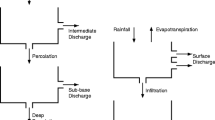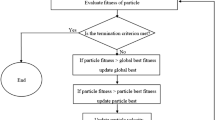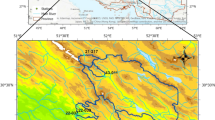Abstract
This study proposes an application of two techniques of artificial intelligence (AI) for rainfall-runoff modeling: the artificial neural networks (ANN) and the evolutionary computation (EC). Two different ANN techniques, the feed forward back propagation (FFBP) and generalized regression neural network (GRNN) methods are compared with one EC method, Gene Expression Programming (GEP) which is a new evolutionary algorithm that evolves computer programs. The daily hydrometeorological data of three rainfall stations and one streamflow station for Juniata River Basin in Pennsylvania state of USA are taken into consideration in the model development. Statistical parameters such as average, standard deviation, coefficient of variation, skewness, minimum and maximum values, as well as criteria such as mean square error (MSE) and determination coefficient (R 2) are used to measure the performance of the models. The results indicate that the proposed genetic programming (GP) formulation performs quite well compared to results obtained by ANNs and is quite practical for use. It is concluded from the results that GEP can be proposed as an alternative to ANN models.
Similar content being viewed by others
References
Agarwal A and Singh R D 2004 Runoff modeling through back propagation artificial neural network with variable rainfall-runoff data; Water Resources Management 18 285–300.
Antar M A, Elassiouti I and Alam M N 2006 Rainfall-runoff modeling using artificial neural networks technique: a Blue Nile catchment case study; Hydrological Process 20 1201–1216.
Aytek A and Kişi Ö 2008 A genetic programming approach to suspended sediment modeling; J. Hydrol. 351 288–298.
Babovic V and Keijzer M 2002 Rainfall runoff modelling based on genetic programming; Nordic Hydrology 33(5) 331–346.
Banzhaf W, Nordin P, Keller R E and Francone F D 1998 Genetic Programming; Morgan Kaufmann, San Francisco, CA.
Chiang Y M, Chang L C and Chang J F 2004 Comparison of static-feed forward and dynamic-feedback neural networks for rainfall-runoff modeling; J. Hydrol. 290 297–311.
Cigizoglu H K and Alp M 2004 Rainfall-runoff modeling using three neural network methods; Lecture Notes in Artificial Intelligence (Lecture Notes in Computer Science); Springer-Verlag, 166–171.
Cousin N and Savic D A 1997 A rainfall-runoff model using genetic programming; Centre for Systems and Control Engineering, Report No. 97/03, School of Engineering, University of Exeter, Exeter, United Kingdom, p. 70.
Darwin C 1864 On the origin of species by means of natural selection or the preservation of favoured races in the struggle for life; Cambridge, UK, Cambridge University Press, sixth edition, originally published in 1859.
Dawson C W and Wilby R 1998 An artificial neural network approach to rainfall-runoff modeling; Hydr. Sci. 43 47–66.
Dorado J, Rabunal J R, Pazos A, Rivero D, Santos A and Puertas J 2003 Prediction and modeling of the rainfall-runoff transformation of a typical urban basin using ANN and GP; Applied Artificial Intelligence 17 329–343.
Drecourt J P 1999 Application of neural networks and genetic programming to rainfall-runoff modeling, D2K Technical Report 0699-1-1, Danish Hydraulic Institute, Denmark.
Eberhart R C and Dobbins R W 1990 Neural network PC tools: A practical guide; Academic Press, San Diego, 414p.
Fernando D A K and Jayawardena A W 1998 Runoff forecasting using RBF networks with OLS algorithm; J. Hydrol. Engg. 3 203–209.
Ferreira C 2001a Gene expression programming in problem solving; 6th online world conference on soft computing in industrial applications (invited tutorial).
Ferreira C 2001b Gene expression programming: A new adaptive algorithm for solving problems; Complex Systems 13 87–129.
Ferreira C 2002 Gene expression programming: mathematical modeling by an artificial intelligence, Springer-Verlag, Germany.
Ferreira C 2006 Gene expression programming; mathematical modeling by an artificial intelligence; Springer-Berlin: Heidelberg: Newyork.
Garbrecht J D 2006 Comparison of three alternative ANN designs for monthly rainfall-runoff simulation; J. Hydrol. Engg. 11 502–505.
Giustolisi O 2004 Using genetic programming to determine Chezy resistance coefficient in corrugated channels; J. Hydroinformatics 157–173.
Guven A, Aytek A, Yuce M I and Aksoy H 2008 Genetic programming-based empirical model for daily reference evapotranspiration estimation; Clean-Soil Air Water (accepted for publication).
Harris E L, Babovic V and Falconer R A 2003 Velocity predictions in compound channels with vegetated floodplains using genetic programming; Intl. J. River Basin Management 1 117–123.
Hsu K, Gupta H V and Sorooshian S 1995 Artificial neural network modeling of the rainfall-runoff process; Water Resources Research 31 2517–2530.
Koza J R 1992 Genetic programming: on the programming of computers by means of natural selection, Cambridge, MA: The MIT Press.
Loke E, Warnaar E A, Jacobsen P, Nelen F and Almeida D C M 1997 Artificial neural networks as a tool in urban storm drainage; Water Science and Technology 36 101–109.
Mason J C, Price R K and Temme A 1996 A neural network model of rainfall-runoff using radial basis functions; J. Hydraulic Res. 34 537–548.
Minns A W and Hall M J 1996 Artificial neural networks as rainfall-runoff models; J. Hydrol. Sci. 41 399–417.
Palit A K and Popovic D 2005 Computational intelligence in time series forecasting; theory and engineering applications; Springer-Verlag, London.
Rabunal J R, Puertas J, Suarez J and Rivero D 2007 Determination of the unit hydrograph of a typical urban basin using genetic programming and artificial neural networks; Hydrological Processes 21 476–485.
Rajurkar M P, Kothyari U C, Chaube U C 2002 Artificial neural network for daily rainfall-runoff modeling; J. Hydrol. Sci. 47(6) 865–877.
Rajurkar M P, Kothyari U C and Chaube U C 2004 Modeling of the daily rainfall-runoff relationship with artificial neural network; J. Hydrol. 285 96–113.
Riad S and Mania J 2004 Rainfall-runoff model using an artificial neural network approach; Mathematical and Computer Modeling 40 839–846.
Savic A D, Walters A G and Davidson J W 1999 A genetic programming approach to rainfall-runoff modeling; Water Resources Management 13 219–231.
Sajikumara N and Thandaveswara B S 1999 A non-linear rainfall-runoff model using an artificial neural network; J. Hydrol. 216 32–55.
Shamseldin A Y, O’Connor K M and Liang G C 1997 Methods for combining the outputs of the different rainfall-runoff models; J. Hydrol. 197 203–229.
Shamseldin A Y 1997 Application of a neural network technique to rainfall-runoff modeling; J. Hydrol. 199 272–294.
Smith J and Eli R N 1995 Neural-network models of rainfall-runoff process; J. Water Resour. Plng. and Mgmt. 121 499–508.
Specht D F 1991 A general regression neural network; IEEE Transactions on Neural Networks 2 568–576.
Srinivasulu S and Jain A 2006 A comparative analysis of training methods for artificial neural network rainfall-runoff models; Applied Soft Computing 6 295–306.
Tayfur G and Singh V P 2006 ANN and fuzzy logic models for simulating event-based rainfall-runoff; J. Hydrol. Engg. 132 1321–1330.
Tayfur G, Moramoroco T and Singh V P 2007 Predicting and forecasting flow discharge at sites receiving significant lateral inflow; Hydrol. Process. 21 1848–1859.
Tokar A S and Johnson P A 1999 Rainfall-runoff modeling using artificial neural networks; J. Hydrol. Engg. 4 232–239.
Tokar A S and Marcus M 2000 Precipitation-runoff modeling using artificial neural networks and conceptual models; J. Hydrol. Engg. 5 156–161.
Whigham P A and Crapper P F 1999 Time series modeling using genetic programming: An application to rainfall-runoff models, Advances in Genetic Programming (eds) L Spector et al., 89–104. Cambridge, MA: The MIT Press.
Whigham P A and Crapper P F 2001 Modeling rainfall-runoff using genetic programming; Mathematical and Computer Modeling 33 707–721.
Author information
Authors and Affiliations
Corresponding author
Rights and permissions
About this article
Cite this article
Aytek, A., Asce, M. & Alp, M. An application of artificial intelligence for rainfall-runoff modeling. J Earth Syst Sci 117, 145–155 (2008). https://doi.org/10.1007/s12040-008-0005-2
Received:
Revised:
Accepted:
Published:
Issue Date:
DOI: https://doi.org/10.1007/s12040-008-0005-2




